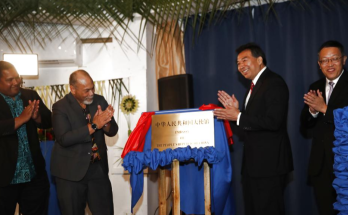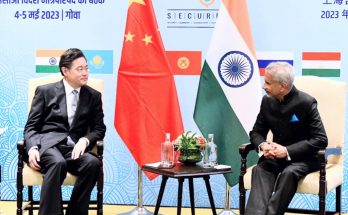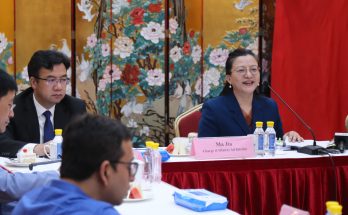 The Narendra Modi government is playing its own version of Chinese checkers as India pushed the envelope for ties with Vietnam by agreeing to supply naval vessels to Hanoi and underlined its strategic intent to spur the modernisation of the military infrastructure in the Southeast Asian country.
The Narendra Modi government is playing its own version of Chinese checkers as India pushed the envelope for ties with Vietnam by agreeing to supply naval vessels to Hanoi and underlined its strategic intent to spur the modernisation of the military infrastructure in the Southeast Asian country.
In defiance of Chinese objections, the prime ministers of India and Vietnam met in Delhi and decided to ramp up their defence and energy ties. Vietnam Prime Minister Nguyen Tan Dung’s visit to Delhi was advertised as predominantly focused on galvanising economic aspects of the relationship, but has ended up as delivering clear-cut outcomes in military and strategic spheres. After wide-ranging talks with his Vietnamese counterpart in New Delhi October 28, India’s Prime Minister Narendra Modi announced that India will quickly activate a $100 million Line of Credit that will enable Hanoi to buy four naval patrol vessels. These India-supplied vessels will help Vietnam to protect its sovereignty interests in South China Sea where it is locked into a bitter territorial spat with China.
“Our defence cooperation with Vietnam is among our most important ones. India remains committed to the modernisation of Vietnam’s defence and security forces,” Mr Modi said after his talks with Mr Tan. The enhanced modernisation programme include expansion of training programme, joint exercises and cooperation in defence equipment. “We will quickly operationalise the 100 million dollars LoC that will enable Vietnam acquire new naval vessels from India. We have also agreed to enhance our security cooperation, including in counter-terrorism,” Modi said. “They expressed hope that the ongoing robust defence and security cooperation between India and Vietnam will continue to be strengthened through regular exchanges at high level,” said a joint statement after the talks.
This explicit articulation of India’s strategic intent to assist in the upgradation of Vietnam’s military stands out in stark contrast to thediffidence and ambivalence of the previous Manmohan Singh government which tended to follow the policy of “this far and no further” vis-à-vis Vietnam in deference to China’s sensitivities.
Significantly, India also conveyed to Vietnam that it was willing to supply Russia-aided BrahMos missiles to Hanoi, but that may have to wait till New Delhi manouevers its entry into the Missile Technology Control Regime (MTCR).
Churn in South China Sea
The ferment in South China Sea, the site of conflicting territorial claims by China, Vietnam and other Southeast Asian countries, also came up for discussions. The leaders called for “restraint” and “freedom of navigation” in the South China Sea,” and “agreed that freedom of navigation and overflight in the East Sea/South China Sea should not be impeded.” “The (leaders called on the) parties concerned to exercise restraint, avoid threat or use of force and resolve disputes through peaceful means in accordance with universally recognised principles of international law,” said the joint statement.
Behind Delhi-Hanoi bonhomie
 India’s proactive military and economic diplomatic engagement with Vietnam indicates that the Modi government is set to be more assertive in countering China’s designs in India’s immediate and extended neighbourhood. India has watched warily as China has deliberately expanded its economic and military footprints in India’s neighbouring countries. In blithe disregard of New Delhi’s sensitivities, a Chinese submarine docked in Sri Lanka’s waters recently and China’s President Xi Jinping offered substantial military and economic assistance to Colombo during his visit to the island nation last month. Similarly, Xi Jinping’s visit to the Maldives underscored Beijing’s calculated strategy to deepen its forays into India’s ambient neighbourhood.
India’s proactive military and economic diplomatic engagement with Vietnam indicates that the Modi government is set to be more assertive in countering China’s designs in India’s immediate and extended neighbourhood. India has watched warily as China has deliberately expanded its economic and military footprints in India’s neighbouring countries. In blithe disregard of New Delhi’s sensitivities, a Chinese submarine docked in Sri Lanka’s waters recently and China’s President Xi Jinping offered substantial military and economic assistance to Colombo during his visit to the island nation last month. Similarly, Xi Jinping’s visit to the Maldives underscored Beijing’s calculated strategy to deepen its forays into India’s ambient neighbourhood.
This larger geopolitical calculation perhaps explains the decision of New Delhi to roll out the red carpet for Vietnam’s prime minister a little over a month after President Pranab Mukherjee’s substantive visit to Vietnam.
Taking a long-range view, the diplomatic-strategic establishment of both India and China needs to initiate a sincere dialogue on their conflictual interests in what is perceived to be each other’s sphere of interest in South Asia and Southeast Asia.
Author Profile

- Manish Chand is Founder-CEO and Editor-in-Chief of India Writes Network (www.indiawrites.org) and India and World, a pioneering magazine focused on international affairs. He is CEO/Director of TGII Media Private Limited, an India-based media, publishing, research and consultancy company.
Latest entries
 India and the WorldMarch 3, 2024India-Denmark Connect: Red carpet for Indians to Red Sea cooperation
India and the WorldMarch 3, 2024India-Denmark Connect: Red carpet for Indians to Red Sea cooperation India and the WorldFebruary 17, 2024Munich Security Conference: Jaishankar, Blinken focus on Red Sea, Middle East
India and the WorldFebruary 17, 2024Munich Security Conference: Jaishankar, Blinken focus on Red Sea, Middle East India and the WorldFebruary 14, 2024Munich Security Conference report: Migration, war top security threats
India and the WorldFebruary 14, 2024Munich Security Conference report: Migration, war top security threats India and the WorldJanuary 23, 2024With “Ram to Rashtra” mantra, Modi consecrates Ram temple for national renewal
India and the WorldJanuary 23, 2024With “Ram to Rashtra” mantra, Modi consecrates Ram temple for national renewal







